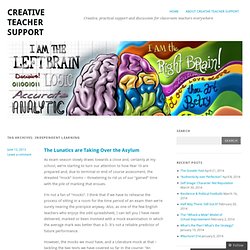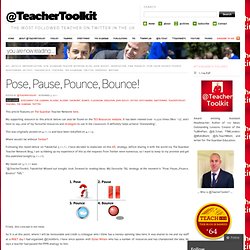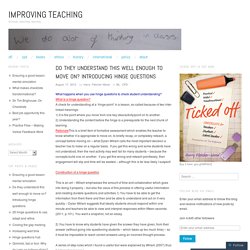Questions?
> Mramsden
Dylan. Geoff. Questioning. The most commonly used questioning methods are the least effective – and it matters*.

Take for example the “volunteers” approach: you ask a question; hands go up; you choose someone to answer; they answer; you comment on that answer. What is wrong with this? Many students keep their hands down, and may not even listen to your questions.You only learn what one student thinks, not how all the rest would have answered.Students don’t discuss their answers and correct each others’ misconceptions.The best students answer quickly, so there is little time for the others to think out their own answers. You can of course choose a series of students to answer without using ‘hands up’, this is the ‘nominees’ approach. But: This can be scary for many students.A student who has just answered will guess that it will be ages before you ask them again. Compare these very common approaches with the much more effective “Assertive Questioning” approach.
Buzz groups work on a thought provoking question.
Creative Teacher Support. As exam season slowly draws towards a close and, certainly at my school, we’re starting to turn our attention to how Year 10 are prepared and, due to terminal or end of course assessment, the dreaded “mock” looms – threatening to rid us of our “gained” time with the pile of marking that ensues.

I’m not a fan of “mocks”. I think that if we have to rehearse the process of sitting in a room for the time period of an exam then we’re surely nearing the precipice anyway. Also, as one of the few English teachers who enjoys the odd spreadsheet, I can tell you I have never delivered, marked or been involved with a mock examination in which the average mark was better than a D. It’s not a reliable predictor of future performance. However, the mocks we must have, and a Literature mock at that – tackling the two texts we have covered so far in the course: “An Inspector Calls” (sorry Mr Gove!)
Assessment for Learning: why, what and how, Dylan Wiliam, Institute of Education, University of. Questioning. What do the questions teachers ask in class really reveal about student learning?

It is perhaps the most familiar of all classroom routines: A teacher asks the class a question, several students raise their hands, the teacher selects one of those with a hand raised, the student gives a response, the teacher evaluates the student’s response, and the cycle begins again. Education researchers call it the standard classroom transaction model or just I-R-E(for initiation-response-evaluation). You will find this model played out it in the vast majority of classrooms in every country in the world. Teachers use this routine to assess where students are so that they can plan next steps. Yet just about every aspect of this scenario actually gets in the way of learning—and it doesn’t provide enough information on what most students in the class know and need to learn.
Pose Pause Pounce. Pose, Pause, Pounce, Bounce!
This article features on The Guardian Teacher Network here.

My supporting resource to this article below can also be found on the TES Resources website. It has been viewed over 10,500 times (Nov ’12), and I have to say…one of my favourite resources and strategies to use in the classroom. It definitely helps achieve ‘Outstanding’. This was originally posted on 4.11.12 and have been redrafted on 4.1.13. Where would I be without Twitter? Following this tweet below on #ukedchat 3.11.11, I have decided to elaborate on this AfL strategy, before sharing it with the world via The Guardian Teacher Network Blog. My tweet on 3.11.11 was:“@TeacherToolkit, #ukedchat Missed out tonight, look forward to reading ideas. Firstly, this concept is not mine. So it is at this point, where I will be honourable and credit a colleague who I think has a money-spinning idea here.
Do they understand this well enough to move on? Introducing hinge questions.
What happens when you use hinge questions to check student understanding?

What is a hinge question? A check for understanding at a ‘hinge-point’ in a lesson, so-called because of two inter-linked meanings: 1) It is the point where you move from one key idea/activity/point on to another. 2) Understanding the content before the hinge is a prerequisite for the next chunk of learning. RationaleThis is a brief item of formative assessment which enables the teacher to know whether it is appropriate to move on, to briefly recap, or completely reteach, a concept before moving on – what Dylan Wiliam calls the most important decision a teacher has to make on a regular basis.
If you get this wrong and some students have not understood, then the next activity may well fail for many students – because the concepts build one on another. if you get this wrong and reteach pointlessly, then engagement will slip and time will be wasted – although this is far less likely I suspect! Limitations and Problems.





